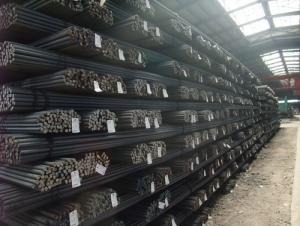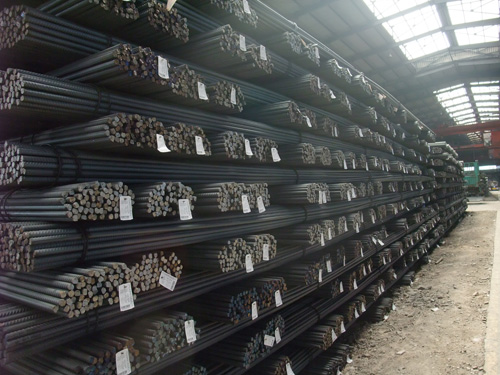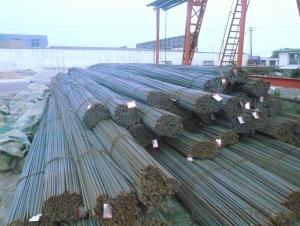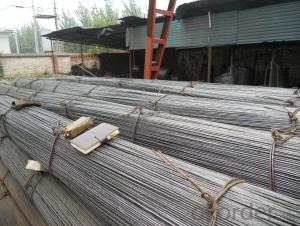Steel Rebar Deformed Bar High Quality Hot Rolled Steel
- Loading Port:
- China Main Port
- Payment Terms:
- TT or LC
- Min Order Qty:
- -
- Supply Capability:
- -
OKorder Service Pledge
OKorder Financial Service
You Might Also Like
Product Description:
OKorder is offering Steel Rebar Deformed Bar High Quality Hot Rolled Steelat great prices with worldwide shipping. Our supplier is a world-class manufacturer of steel, with our products utilized the world over. OKorder annually supplies products to European, North American and Asian markets. We provide quotations within 24 hours of receiving an inquiry and guarantee competitive prices.
Product Applications:
Steel Rebar Deformed Bar High Quality Hot Rolled Steel are ideal for structural applications and are widely used in the construction of buildings and bridges, and the manufacturing, petrochemical, and transportation industries.
Product Advantages:
OKorder's Steel Rebar Deformed Bar High Quality Hot Rolled Steel are durable, strong, and resist corrosion.
Main Product Features:
· Premium quality
· Prompt delivery & seaworthy packing (30 days after receiving deposit)
· Corrosion resistance
· Can be recycled and reused
· Mill test certification
· Professional Service
· Competitive pricing
Product Specifications:
Specifications of HRB500 Deformed Steel Bar:
Standard | GB | HRB500 |
Diameter | 6mm,8mm,10mm,12mm,14mm,16mm,18mm,20mm, 22mm,25mm,28mm,32mm,36mm,40mm,50mm | |
Length | 6M, 9M,12M or as required | |
Payment term | TT or L/C | |
Application | mainly used in construction industry to reinforce concrete structures and so on | |
Quality | First quality, the goods are from Chinese big manufacturers. | |
Type | Hot rolled deformed steel bar | |
Brand name | DRAGON | |
Chemical Composition: (Please kindly find our chemistry of our material based on HRB500 as below for your information)
Grade | Technical data of the original chemical composition (%) | ||||||
C | Mn | Si | S | P | V | ||
HRB500 | ≤0.25 | ≤1.60 | ≤0.80 | ≤0.045 | ≤0.045 | 0.08-0.12 | |
Physical capability | |||||||
Yield Strength (N/cm²) | Tensile Strength (N/cm²) | Elongation (%) | |||||
≥500 | ≥630 | ≥12 | |||||
Theoretical weight and section area of each diameter as below for your information:
Diameter(mm) | Section area (mm²) | Mass(kg/m) | Weight of 12m bar(kg) |
6 | 28.27 | 0.222 | 2.664 |
8 | 50.27 | 0.395 | 4.74 |
10 | 78.54 | 0.617 | 7.404 |
12 | 113.1 | 0.888 | 10.656 |
14 | 153.9 | 1.21 | 14.52 |
16 | 201.1 | 1.58 | 18.96 |
18 | 254.5 | 2.00 | 24 |
20 | 314.2 | 2.47 | 29.64 |
22 | 380.1 | 2.98 | 35.76 |
25 | 490.9 | 3.85 | 46.2 |
28 | 615.8 | 4.83 | 57.96 |
32 | 804.2 | 6.31 | 75.72 |
36 | 1018 | 7.99 | 98.88 |
40 | 1257 | 9.87 | 118.44 |
50 | 1964 | 15.42 | 185.04 |
Usage and Applications of HRB500 Deformed Steel Bar:
Deformed bar is widely used in buildings, bridges, roads and other engineering construction. Big to highways, railways, bridges, culverts, tunnels, public facilities such as flood control, dam, small to housing construction, beam, column, wall and the foundation of the plate, deformed bar is an integral structure material. With the development of world economy and the vigorous development of infrastructure construction, real estate, the demand for deformed bar will be larger and larger..
Packaging & Delivery of HRB500 Deformed Steel Bar:
Packaging Detail: products are packed in bundle and then shipped by container or bulk vessel, deformed bar is usually naked strapping delivery, when storing, please pay attention to moisture proof. The performance of rust will produce adverse effect.
Each bundle weight: 2-3MT, or as required
Delivery Detail: within 45 days after received advanced payment or LC.
Label: to be specified by customer, generally, each bundle has 1-2 labels
Trade terms: FOB, CFR, CIF
FAQ:
Q1: How do we guarantee the quality of our products?
A1: We have established an advanced quality management system which conducts strict quality tests at every step, from raw materials to the final product. At the same time, we provide extensive follow-up service assurances as required.
Q2: How soon can we receive the product after purchase?
A2: Within three days of placing an order, we will begin production. The specific shipping date is dependent upon international and government factors, but is typically 7 to 10 workdays.
Q3: Can stainless steel rust?
A3: Stainless does not "rust" as you think of regular steel rusting with a red oxide on the surface that flakes off. If you see red rust it is probably due to some iron particles that have contaminated the surface of the stainless steel and it is these iron particles that are rusting. Look at the source of the rusting and see if you can remove it from the surface.
Images:
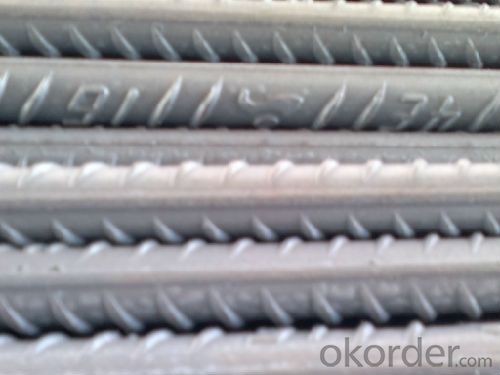

- Q: Can steel rebars be used in composite construction systems?
- Yes, steel rebars can be used in composite construction systems. Steel rebars are commonly used as reinforcement in composite structures to enhance their strength and durability. The rebars are embedded within the composite materials, such as concrete or fiber-reinforced polymers, to provide additional tensile strength and structural integrity. This combination of materials allows for a more efficient and cost-effective construction system.
- Q: What are the main uses of threaded steel?
- The difference between round bar and round bar is that the surface has longitudinal ribs and transverse ribs, usually with two longitudinal ribs and transverse ribs uniformly distributed along the length direction.
- Q: Can steel rebars be used in structures with extreme temperature variations?
- Yes, steel rebars can be used in structures with extreme temperature variations. Steel is known for its excellent thermal conductivity, which allows it to expand and contract with temperature changes. Additionally, steel rebars have high tensile strength and can withstand the mechanical stresses induced by temperature fluctuations, making them suitable for use in such structures.
- Q: Can steel rebars be used in the construction of underground parking facilities?
- Yes, steel rebars can be used in the construction of underground parking facilities. Steel rebars are commonly used in reinforced concrete structures, including underground parking facilities, to provide the necessary strength and structural support. The use of steel rebars helps to enhance the durability and load-bearing capacity of the structure, making it suitable for underground parking facilities that require strong foundations and resistance to potential structural stresses.
- Q: Can steel rebars be used in swimming pools and water tanks?
- Swimming pools and water tanks can indeed utilize steel rebars. These structures often rely on steel rebars for added strength and stability. During construction, the rebars are typically inserted into the concrete or masonry walls of the pool or tank. Notably, steel rebars possess exceptional durability and corrosion resistance, rendering them an optimal choice for these applications which entail constant exposure to water. Furthermore, the incorporation of steel rebars aids in averting cracks and enhancing the overall structural integrity of the pool or tank.
- Q: How are steel rebars different from other types of reinforcement?
- Steel rebars are different from other types of reinforcement primarily because they are made of steel, which gives them high tensile strength and durability. Unlike other materials like wood or concrete, steel rebars can withstand heavy loads and provide structural integrity to reinforced concrete structures. Additionally, steel rebars can be easily molded and shaped into various designs, making them versatile and suitable for different construction applications.
- Q: How do steel rebars affect the overall corrosion resistance of marine structures?
- Steel rebars have a significant impact on the overall corrosion resistance of marine structures. The presence of steel rebars in concrete marine structures can enhance or deteriorate their resistance to corrosion, depending on various factors. Firstly, steel rebars can enhance corrosion resistance when proper preventive measures are taken. For instance, if the rebars are adequately coated with anti-corrosion materials such as epoxy or zinc, they can provide an extra layer of protection against the corrosive effects of seawater. Additionally, proper concrete cover and compaction during construction can help prevent the penetration of seawater to the rebars, reducing the risk of corrosion. On the other hand, if steel rebars are not properly coated or if the concrete cover is insufficient, they can contribute to the degradation of marine structures. When exposed to the aggressive marine environment, rebars can undergo corrosion, leading to the formation of rust. The rust occupies more space than steel, causing an expansion that exerts pressure on the surrounding concrete. This pressure can result in cracking and spalling of the concrete, further exposing the rebars to corrosion and compromising the overall structural integrity of the marine structure. To mitigate the negative effects of steel rebars on corrosion resistance, regular maintenance and inspection are crucial. Periodic inspections can help identify any signs of corrosion, allowing for timely repairs or replacement of rebars. Additionally, cathodic protection systems can be implemented to provide an electrochemical countermeasure against corrosion, ensuring the longevity and durability of the marine structure. In conclusion, steel rebars play a vital role in the corrosion resistance of marine structures. Proper coating, concrete cover, and maintenance measures are essential in ensuring the rebars' positive contribution to corrosion resistance, while neglecting these factors can lead to the degradation of marine structures.
- Q: Can steel rebars be used in historical building restoration?
- Historical building restoration can benefit from the incorporation of steel rebars. These rebars are commonly used in construction to enhance the strength and durability of concrete structures. In the case of restoring historical buildings, the primary objective is to preserve the structure's original charm and aesthetics, while also guaranteeing its structural soundness. To achieve this, careful integration of steel rebars is possible to reinforce weak areas or replace sections that have deteriorated or suffered damage. This utilization of rebars results in a more stable and long-lasting structure, ensuring the building's endurance for future generations. Nevertheless, it is crucial to ensure that the incorporation of steel rebars in historical building restoration is executed in a manner that respects the structure's historical value. The discreet integration of rebars is necessary to avoid compromising the building's original appearance or architectural features. Moreover, any restoration work undertaken on historical buildings should adhere to strict preservation guidelines and be carried out by skilled professionals well-versed in historical preservation. By doing so, the restoration process maintains the historical integrity of the building while incorporating necessary structural reinforcements, such as steel rebars.
- Q: Can steel rebars be bent on site?
- Yes, steel rebars can be bent on site.
- Q: Can steel rebars be used in sports stadium construction?
- Yes, steel rebars can be used in sports stadium construction. Steel rebars are commonly used as reinforcement in concrete structures, including sports stadiums, to enhance the strength and durability of the overall construction. The strong and durable nature of steel rebars makes them ideal for withstanding the heavy loads and stresses that sports stadiums often experience.
Send your message to us
Steel Rebar Deformed Bar High Quality Hot Rolled Steel
- Loading Port:
- China Main Port
- Payment Terms:
- TT or LC
- Min Order Qty:
- -
- Supply Capability:
- -
OKorder Service Pledge
OKorder Financial Service
Similar products
Hot products
Hot Searches
Related keywords
